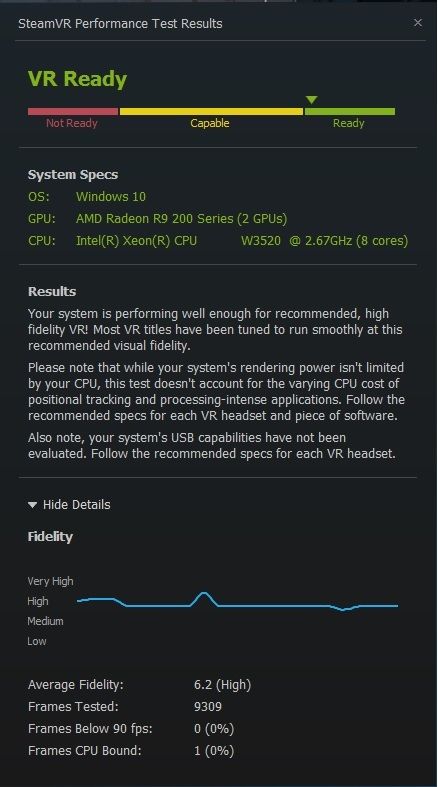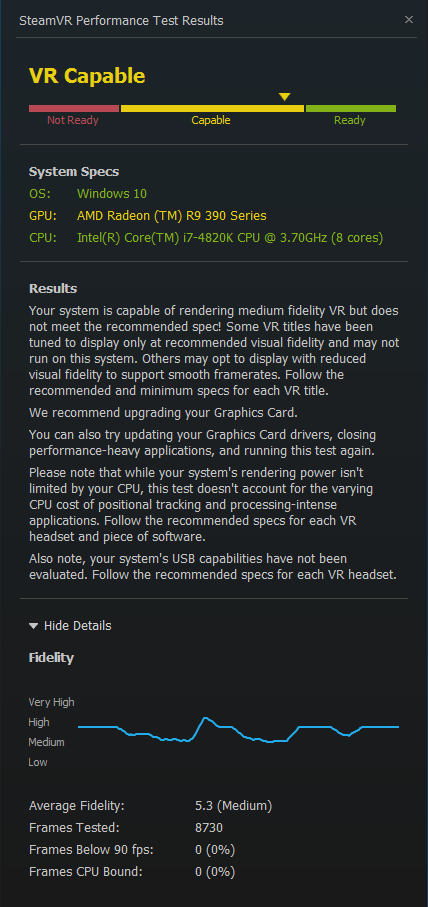aeonrevolution
2[H]4U
- Joined
- Aug 30, 2004
- Messages
- 2,571
I think it was 8,200 frame rendered with 22% dropping below 90fps
Follow along with the video below to see how to install our site as a web app on your home screen.
Note: This feature may not be available in some browsers.
Frame rate required is 90+, so even though it appeared smooth on a 2d monitor, it wasn't smooth enough for VR.Okay.... I have a legit question. Is the thing it is rendering going to be exactly what would be rendered if I were playing a game? If so, it gave me Not Ready, but the benchmark ran fluid as can be.
I'm guessing it has to do with the frame rate?
I thought I would snuck in with an overclocked 7950 boost and a 4770k @ 4.0
That's because VR is mostly taxing to the GPU. There is extra load on the CPU for motion tracking and whatnot but VR is mostly GPU heavy.

You should disable CF and rerun the utility to get a more accurate analysis. At the moment, CF/SLI is not supported in VR due to the added latency when using multiple GPUs.
The cards that keep on giving! My 280x cards are VR Ready!
You should disable CF and rerun the utility to get a more accurate analysis. At the moment, CF/SLI is not supported in VR due to the added latency when using multiple GPUs.
I understand that, but it's still not supported by Oculus or HTC/Valve.AMD added CF support in their last driver release for SteamVR.
my single 980 Ti setup scored an 11 too!How'd you beat me by 0.1!?
I understand that, but it's still not supported by Oculus or HTC/Valve.
While the technologies are out there, Oculus and HTC/Vive have not announced multi-gpu support and their official stance is still that multi-gpu configurations are not recommended due to their added latency. I personally think it's best that you root your expectations within the given reality. Technologies are being developed to add multi-gpu support but until the HMD manufacturers announce support for those configurations, I wouldn't put my hopes in that kind of setup working well...especially considering the physical consequences to your well-being that running an unsupported configuration can induce.I believe Valve updated SteamVR to enable support for multi-card, which was disabled in the first release and AMD had a driver ready. Also Liquid VR which is to be used with Oculus and Vive specifically supports Crossfire for VR as promoted with the Fury X2 so I don't see the point of disabling Crossfire at this point.
While the technologies are out there, Oculus and HTC/Vive have not announced multi-gpu support and their official stance is still that multi-gpu configurations are not recommended due to their added latency. I personally think it's best that you root your expectations within the given reality. Technologies are being developed to add multi-gpu support but until the HMD manufacturers announce support for those configurations, I wouldn't put my hopes in that kind of setup working well...especially considering the physical consequences to your well-being that running an unsupported configuration can induce.
While the technologies are out there, Oculus and HTC/Vive have not announced multi-gpu support and their official stance is still that multi-gpu configurations are not recommended due to their added latency. I personally think it's best that you root your expectations within the given reality. Technologies are being developed to add multi-gpu support but until the HMD manufacturers announce support for those configurations, I wouldn't put my hopes in that kind of setup working well...especially considering the physical consequences to your well-being that running an unsupported configuration can induce.


It's not gonna make a difference if it's fullscreen.well booo... i JUST bought this 8GB 390 too.
does is only test a window? is there a way to test a full screen?
View attachment 649
It's not optimized for AMD hardware. Your score is better than mine when I had a 290X, I was barely getting 'Low'There has to be something really strange with the test. It seems like the results are all over the place and card that should be beating my R9 290 and getting a worse score.